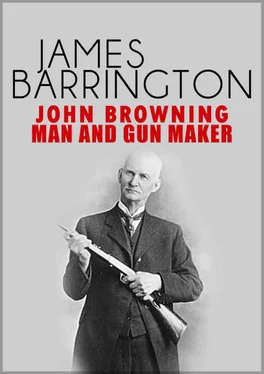Whatever the truth of that story, everybody who used the weapon in combat praised both its total reliability, no matter what the conditions, and its prodigious stopping power. The design has been produced in one form or another by almost every major weapon manufacturer in the world, and has proved to be arguably the most successful semi-automatic pistol ever made. The only conceivable challenger to this title is the Browning Hi-Power which is also, of course, also a Browning design. Total manufacturing figures of the M1911 have never been assessed.
Despite being heavily involved with his work with Colt, Browning did not neglect his responsibilities at the FN factory and supplied the company with a succession of highly successful pistol designs, including the Model 1922 and, of course, the pistol for which the name Browning is best known; the Model 35 or Hi-Power. This pistol represented a logical development, and simplification, of Browning’s earlier designs, and most notably that of the Colt 1911, which externally closely resembles the slightly smaller Browning.
John Browning’s remark to his bothers in 1889, after the experiment with the Model 73 and the block of wood, that he might be able to build a machine-gun in about ten years was extremely pessimistic. In November 1890, just over a year later, Matt Browning wrote to Colt and offered to demonstrate just such a weapon. John had chosen to contact Colt because the company had made the hand-cranked Gatling gun, and was about the only major arms manufacturer in America with any experience of machine-guns. This was actually the first contact between the Brownings and Colt, though certainly the Colt management knew who they were — indeed, in their reply to Matt they made specific reference to the fine qualities of the Winchester 86 — and extended an invitation for the Brownings to visit Hartford.
John and Matt arrived at the Colt factory in Hartford early in 1891, bringing with them the prototype machine-gun and four belts of ammunition. The weapon was the world’s first gas-operated machine-gun, a system which was to surpass mechanical recoil operation as the standard design for the vast majority of high-powered self-loading weapons in the future.
John had considerable doubts about their mission. The gun looked very rough indeed, heat-blackened and with the hammer marks of its forging still visible, and could not by any stretch of the imagination be considered a production weapon.
But he knew it would work, and the Brownings ignored the doubtful looks on the faces of the Colt president, John Hall, and his works manager. Instead, he and Matt just set up the gun on its mount and prepared it for operation. Then John chambered the first round, checked that everybody was clear of the firing line, and triggered the weapon. The prototype machine-gun blasted two hundred rounds without a single pause or malfunction down the firing tunnel.
When he turned round, all expressions of doubt on the faces of the Colt men had vanished. In fact, John later described Hall as ‘bug-eyed’, and added: ‘The changed expression of Hall and his men put a pound of fat on my ribs’. The Colt team was clearly very impressed. John then explained the reasons for the rough appearance of the weapon, while Matt filled in the background, tracing the development of the gun from that afternoon at Ogden when John saw more than just bending weeds in a muzzle blast. At Hall’s request, the Brownings agreed to stay on in Hartford for a few days to discuss the weapon.
Unfortunately, there was only a fairly limited market for a machine-gun, and there appeared to be little interest in such a weapon at government level, but Hall did suggest an unofficial showing for some officers he knew in the services to attempt to generate some enthusiasm that way. John agreed to bring the gun back if such a demonstration could be arranged, but Hall vetoed his suggestion to try to tidy the weapon up a bit, because he knew how dramatically his own opinion had changed when the gun started firing, and thought it a good move to leave it just as it was.
The expected invitation didn’t come until late in 1891, and it was, as Hall had suggested, an unofficial demonstration to two officers from the Naval Ordnance section. The catch, as far as Browning was concerned, was that they wanted the gun to fire continuously for three minutes, which meant, at the 600 rounds a minute John had adjusted the gun to maintain, eighteen hundred cartridges. While he had no doubts about the gun’s ability to keep firing for three minutes, he was actually quite concerned about the task of stitching and then loading sufficient ammunition belts to provide that number of rounds.
He accepted, persuaded a tentmaker to stitch the belts for him — he had decided on ten belts, each carrying two hundred rounds — and Matt and Ed hand-loaded them for him. John went to Hartford alone, a day early, where he devised and had made a series of wooden boxes, each of which would hold one ammunition belt. He designed these to clip on to the side of the gun, enabling the new belt to be inserted and the firing to continue almost without pause.
At the demonstration, John sat on a bicycle seat attached to one leg of the mount, pulled back the breechblock and let it carry forward, and then pressed the trigger. The next three minutes were a blur of action. The slamming report of the gun, the change of ammunition box every twenty seconds, and the haze of smoke around him. The barrel turned from black to blue, and finally to red, and then the firing stopped, but not because something had broken. It had stopped because all eighteen hundred rounds had been fired.
The officers were ecstatic — the weapon was an almost unbelievable advance on the familiar Gatling — and that evening they all went out to the Heublein Hotel in Hartford to celebrate. There John ate a hearty meal and, for the first time in his life, he drank champagne. As he later remarked, it was just as wall that he had a good meal, because for a long time that was all he did get from the machine-gun. Hall had faith in the weapon, and offered John a generous royalty contract for future sales, but John didn’t sign, and took the weapon back home to Ogden.
There he worked on the gun, as well as continuing to provide Winchester with a seemingly endless stream of new arms, and developed a production model of the machine-gun that was firing within a year, despite the additional problems caused by adopting the mechanism for smokeless powders. The weapon was tested — this time officially — by the US Navy in 1893, and was put into production by Colt two years later as the Colt Model 1895, chambered for either the .30/40 Krag or the 6 mm Lee rounds, these being the calibres used by, respectively, the US Army and US Navy.
Despite its official title, the gun acquired the nickname ‘The Peacemaker’ during the Spanish-American War, echoing that of the earlier Colt revolver, but was more popularly known elsewhere as the ‘Potato Digger’. The reason for this peculiar appellation becomes clear on firing the weapon: if the tripod is mounted too low or placed on soft earth, it will dig into the ground and cause the heavy under-barrel operating lever to churn up the surface, like a piece of agricultural machinery.
In 1895, two years after the first official trial, another one was held, with the Browning weapon competing against a 6 mm Gatling, the Accles Improved Gatling, the Maxim and a French-made machine-gun. The Browning machine-gun easily outclassed the other weapons and convincingly demonstrated its superiority. As a result, the US Navy ordered fifty units from Colt in 1896. These were used to devastating effect by the Marines in Peking during the Boxer rebellion, and a further 150 weapons were ordered in 1898. The US Army, for no readily apparent reason, elected to continue using the antiquated, slow, inaccurate and unreliable hand-cranked Gatling.
Читать дальше












